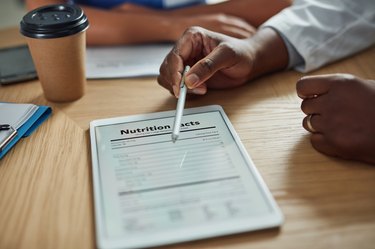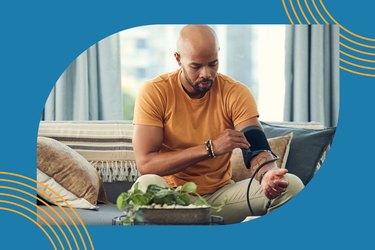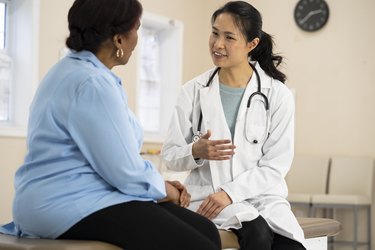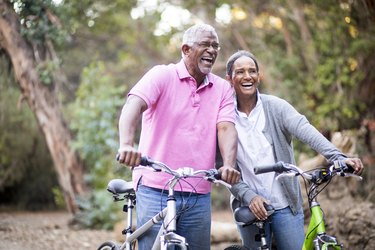
Type 2 diabetes is the number one reason Amy DeLong, MD, MPH, sees patients at the Ho-Chunk Nation House of Wellness Clinic in Baraboo, Wisconsin.
That's because a disproportionate number of Native Americans has diabetes. While 14.5 percent of American Indians/Alaskan Natives (AI/AN) had diabetes in 2019, 11.3 percent of the overall U.S. population did, and only 7.4 percent of non-Hispanic white people did, according to the American Diabetes Association.
Video of the Day
Video of the Day
Dr. DeLong, a citizen of the Ho-Chunk Nation, has been treating Ho-Chunk patients with type 2 diabetes — the most common form — for 17 years. But why do so many Native Americans have diabetes — a condition in which there's too much sugar circulating in your bloodstream, per the Cleveland Clinic — to begin with?
Multiple factors contribute to this disparity, and they can be traced back to historical changes imposed on Native Americans' diets and lifestyles. But Indigenous people across the country, both on and off reservations, are making progress in fighting and preventing diabetes.
Reasons for the Disparity
Factors that contribute to high rates of diabetes in AI/AN people include that they often lack access to health care, have limited access to healthy and traditional foods and have high rates of obesity, according to Carmen Licavoli Hardin, director of the Indian Health Service (IHS) Division of Diabetes Treatment and Prevention.
AI/AN adults are 50 percent more likely to have obesity than non-Hispanic white people, according to the IHS. Obesity and type 2 diabetes are linked because carrying extra weight — especially in your midsection — can lead to insulin resistance, according to Temple Health. (Insulin regulates your blood sugar.)
Insulin resistance happens when your body "can't produce enough insulin, a hormone that helps your body process the energy your cells need," per Temple Health. When your body can't produce enough insulin, too much sugar enters your bloodstream, and you can develop type 2 diabetes.
High rates of poverty and unemployment also contribute to diabetes risk, says LeeAnna Muzquiz, MD, associate dean of admissions at the University of Washington School of Medicine, a practicing family practitioner with the tribal health department for the Confederated Salish and Kootenai Tribes and a member of the Confederated Salish and Kootenai Tribes of the Flathead Reservation in Montana.
"There still are these situations, particularly on reservation communities, that predispose all people to higher rates of diabetes," she tells LIVESTRONG.com.
Poverty often leads to food insecurity, or lack of stable access to enough nutritious food.
"People who don't have access to grocery stores with healthy foods are less likely to have good nutrition. That raises their risk of health conditions like heart disease, diabetes and obesity — and even lowers life expectancy relative to people who do have access to healthy foods," Hardin says.
And these factors stem from colonization in the U.S., which has affected Native Americans' "connection between their culture, community and the production and consumption of food," a September 2021 research report from the Food Research and Action Center (FRAC) points out.
That's because AI/AN people were forced out of their ancestral lands and had to adhere to "forced cultural assimilation policies," per the FRAC report.
"The stressors of having your whole social construct sort of torn apart, over the course of time, really doesn't afford itself to healthy lifestyles."
People who traditionally relied on subsistence farming now live in food deserts, where they lack access to fresh produce, and children rely on school meals that are not very healthy, Dr. DeLong says.
When Indigenous people were displaced from their tribal lands, their lifestyles were disrupted, which often meant they could no longer farm, hunt or fish as they traditionally had, and they became more sedentary.
"Dependence really shifted not onto their individual tribes but to other people," so they had to adapt to the foods that the U.S. government provided to Indigenous people on reservations, Dr. Muzquiz says.
The U.S. government food rations distributed to Indigenous people "were made of culturally unfamiliar foods, including white flour, beef, bacon, sugar, salt and coffee," although traditionally, "Indigenous foods were primarily composed of vegetables, fruits and game meats," notes a February 2023 study in Food Foodways.
In this study, in which Indigenous people were interviewed, "participants spoke frequently about the bulk of their diet consisting of rations and commodities high in flour-based and processed foods that contribute to the development of health conditions such as type 2 diabetes, heart disease and cancer," the researchers wrote.
The Indigenous study participants were able to connect the uptick in diabetes (in addition to other chronic health conditions) with the "forced consumption" of these foods.
But it's not just the physical displacement and change in diet that have led to high rates of diabetes. "The stressors of having your whole social construct sort of torn apart, over the course of time, really doesn't afford itself to healthy lifestyles," Dr. Muzquiz says.
"We know that higher levels of obesity lead to higher levels of diabetes. It's really not that American Indians/Alaska Natives are necessarily genetically predisposed. It gets categorized that way — we have higher rates in our communities — but I think it's because of the social determinants of health," including the historical trauma that these groups have experienced, Dr. Muzquiz says. Social determinants of health are the non-medical factors that influence health outcomes, like access to quality health care and economic stability.
The Food Foodways study notes: "Participants described the aftermath of settler colonial governmental programs and policies that undermined foodways, connectedness, cultural knowledge, family and interpersonal relationships, ceremonies and outdoor activities — all of which promote health and wellness."
Also, diabetes doesn't occur in a vacuum. Patients with diabetes often deal with the simultaneous presence of issues such as substance abuse, high blood pressure, high cholesterol, tobacco abuse and mental health issues, Dr. DeLong says.
Depression is common and is intertwined with diabetes treatment, Dr. DeLong says. "If people are depressed, they don't care about taking their meds, eating more healthfully or walking more," so they may have a harder time managing their blood sugar, she says.
Challenges and Progress
"Access to health care is a treaty right," Dr. Muzquiz points out. But the challenges in addressing diabetes include many of the same risk factors associated with the disease, such as limited income and lack of access to heathy foods and health care. Also, lack of transportation is a barrier to accessing health care, Hardin notes.
Additionally, people in rural areas often face "severe workforce shortages and underfunding and closure of clinics and hospitals," Dr. Muzquiz says. In rural tribal areas, "there are some folks who just don't have service because there's nobody there to provide it."
The IHS is responsible for providing health care to Indigenous people both on reservations and in urban areas, but it "has been historically severely underfunded," which has made access to care a challenge, she says.
Higher rates of poverty, inability to embrace one's cultural identity and dependence on the government for survival lead to a "lower ability to achieve a healthy balance," Dr. Muzquiz says. "All people in our country, if we all could just eat better and get more exercise, our rates of diabetes would probably go down. But when we start peeling back the layers of what are the barriers to those things, I think it becomes much, much, much more complicated."
Still, Indigenous communities have made progress in reducing diabetes. Diabetes in AI/AN adults decreased from 15.4 percent in 2013 to 14.6 percent in 2017, according to an April 2020 review in BMJ Open Diabetes Research & Care, which looked at data from the IHS from 2006 to 2017 (the most recent year from which this data is available).
Within the IHS, the Special Diabetes Program for Indians provides funding for diabetes treatment and prevention to more than 300 IHS, tribal and urban Indian health grant programs. This funding "has enabled staff and programs at the local and national levels to increase access to diabetes treatment and prevention services throughout the Indian health system," Hardin says.
As access to these services has increased, some additional diabetes statistics have improved, including the following, according to the IHS:
- The average blood sugar among American Indian and Alaska Natives with diabetes (measured by the A1C test) decreased from 9 percent in 1996 to 8 percent in 2020.
- The average LDL (bad) cholesterol decreased from 118 mg/dL in 1998 to 89 mg/dL in 2020.
- The rate of new cases of kidney failure due to diabetes, leading to dialysis, declined by 54 percent from 1996 to 2013.
Diabetes treatment options have improved over the years, including new medications and ways of monitoring blood sugar, Dr. DeLong says. The bigger challenge she sees in her community is prevention, she says.
Solutions in Action
Several efforts to tackle diabetes have gained traction. And the ones that seem to be working best often center community members and encourage them to serve as champions or ambassadors, rather than efforts that prescribe what community members should do.
"In much of medicine, the doctor would say, 'You need to go do this,' and there were no questions asked, and people were just expected to do that — and either they did or they didn't," Dr. Muzquiz says. "But once they helped educate the community, met people where they are, invited them in to be part of the strategy," they saw improved outcomes. This includes reducing some complications of diabetes, such as amputations and dialysis, she says.
This kind of approach, centering community members, has helped in medical and other contexts. Without this step, well-meaning initiatives might fall flat.
Food Sovereignty
The movement toward food sovereignty in Indigenous communities helps with both prevention and treatment of diabetes. Food sovereignty is generally defined as people's right to have access to healthy and culturally appropriate foods, and to define and control their own food systems. In Indigenous communities, this sometimes means "developing different relationships with food," Dr. Muzquiz says.
In the Ho-Chunk Nation, for example, the food sovereignty movement involves tribal leaders working with people on community supported agriculture (CSA) and community gardens that bring some of their traditional foods back into their diets, Dr. DeLong says.
And Dr. DeLong has noticed a seasonal change in patients with diabetes who have gardens. "In the fall, when they have their harvest — when their vegetable gardens are bountiful, they have a lot of lettuce and they have tomatoes and cucumbers coming out of their ears — their numbers are better because they have this produce and are eating it," she says. This change signals that gardens and fresh produce can help people better manage diabetes.
Depending on where in the country someone lives, food sovereignty may look different: It may mean more fishing or more gardening, for example, Dr. DeLong says.
Food sovereignty involves reclaiming traditional foods that were native to the region where Indigenous people live, even if the region is not their original territory, Dr. Muzquiz says. It includes "having control over where your food comes from, how fresh it is and what kind of nutritional value it has," as well as how to preserve it, she says.
In practice, this is likely to be a blend of modern and traditional practices, Dr. Muzquiz says. "We can't turn back time and go back to the way we used to live. But we can bring with us those things that gave us sustenance and strength, and that we celebrated historically."
Team-Based Medical Care
In team-based care, multiple health care providers work collaboratively with patients to meet their needs, according to the American College of Physicians.
Medicine in general has moved more toward team-based care, and having multiple people involved in taking care of not just individuals but communities is more like traditional tribal lifestyles.
"Historically, much of what would happen was done as a community," rather than individuals doing things in their own best interests, Dr. Muzquiz says. "It really centers us back to a space where the ideas become easier to relate to in a culturally relevant way."
Dr. DeLong says she has seen this team approach improve diabetes treatment in the Ho-Chunk community. This often includes doctors, nurses, doctors of pharmacy, mental health counselors, dietitians and certified diabetes educators working together, she says.
For example, she recalls a patient whose blood sugar wouldn't budge for years. But after referring the patient to a certified diabetes educator, who could meet with her more frequently than a primary care physician and taught her how to use a skin sensor glucose monitor, Dr. DeLong finally saw the patient's numbers improve.
Awareness and Prevention
Greater awareness of diabetes has also made a difference, especially among younger generations, Dr. DeLong says. "There's a lot more awareness now. Kids know a grandma or an uncle with diabetes, and maybe they've seen them taking insulin."
While people may have been hesitant to use insulin 20 years ago because of misperceptions about it contributing to amputations and other complications, general understanding of diabetes and treatment has improved, she says.
For kids, making school meals healthier and providing opportunities for physical activity — such as biking and skateboarding — can help improve their health overall and reduce their risk of diabetes, Dr. DeLong says.
A program called Together Raising Awareness for Indian Life (TRAIL), which IHS provides funding for, includes physical, educational and nutritional activities to promote healthy lifestyles for American Indian and Alaska Native youth. Self-esteem activities are woven in as well.
People of all ages participate in activities that integrate the tribal traditions and history related to nutrition, food choices and media influences — the effects of type 2 diabetes included, according to Hardin. She says the program has increased knowledge about diabetes, physical activity and the ability to identify healthier food options.
"The fact that Indigenous people are still here speaks to the resiliency, and we're just at a space and time where other people are recognizing that."
Overall, Dr. DeLong says, "the main message is prevention, and that's about creating an environment that makes it easier for people to be more active and eat well. Unfortunately, we live in an environment that promotes overeating and sedentary activity."
The IHS Produce Prescription Pilot Program collaborates with stakeholders from various health care and food industries in tribal communities to help increase access to fruits, vegetables and healthy traditional foods for American Indian and Alaska Native people. Through this new pilot program, people receive fruit and vegetable vouchers from participating health care providers to redeem at local markets.
Efforts to make preventive health campaigns more culturally relevant have helped, Dr. Muzquiz says. "I see that happening in my own communities," she says. People who work in public health "really lean on the community to help us understand how we best disseminate information and get community buy-in to have an understanding of prevention."
Dr. Muzquiz also sees benefits in having community members serve as ambassadors for healthy practices, such as seeing a health practitioner regularly and managing medication. "Investing in the community to help spread the message has been more successful than trying to be the health department that just keeps telling people to live healthier lifestyles," she says.
Although Indigenous people have a high risk of diabetes, efforts to improve both prevention and treatment have gained important ground, often when they have been culturally relevant and conscious of traditional practices.
"The fact that Indigenous people are still here speaks to the resiliency, and we're just at a space and time where other people are recognizing that," Dr. Muzquiz says. "And now we're learning the tools independently for ourselves to be able to take back some of that control and some of that responsibility for better and healthier choices in diets and lifestyles."
- American Diabetes Association: "Statistics About Diabetes"
- Food Research and Action Center: "Hunger, Poverty, and Health Disparities During COVID-19 and the Federal Nutrition Programs’ Role in an Equitable Recovery"
- Food Foodways: ""I don't remember any of us … having diabetes or cancer": How historical oppression undermines indigenous foodways, health, and wellness"
- American College of Physicians: "Team-Based Care Toolkit"
- IHS: "Produce Prescription Pilot Program"
- National Congress of American Indians: "On the T.R.A.I.L."
- BMJ Open Diabetes Research & Care: "Prevalence of diagnosed diabetes in American Indian and Alaska Native adults, 2006–2017"
- Cleveland Clinic: "Diabesity: How Obesity Is Related to Diabetes"
- Temple Health: "How Obesity and Diabetes Are Linked"
Is this an emergency? If you are experiencing serious medical symptoms, please see the National Library of Medicine’s list of signs you need emergency medical attention or call 911.





